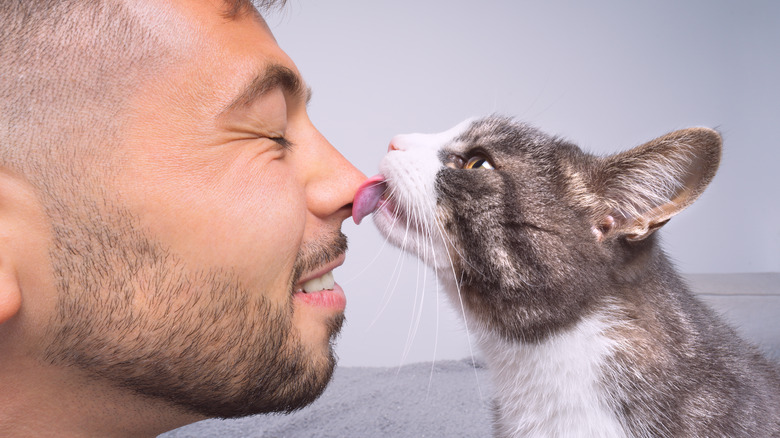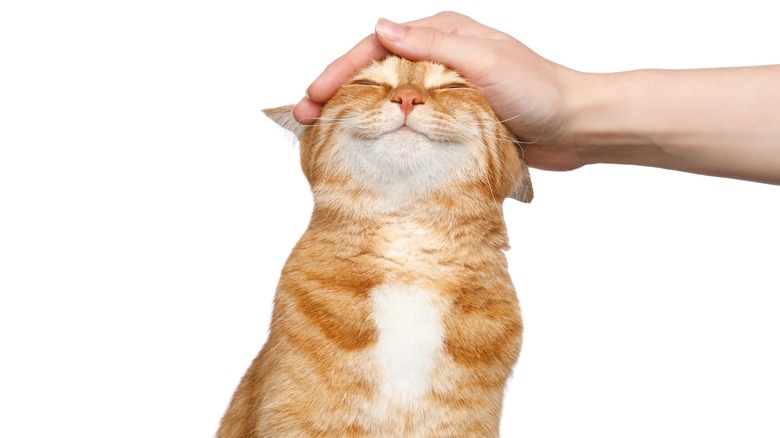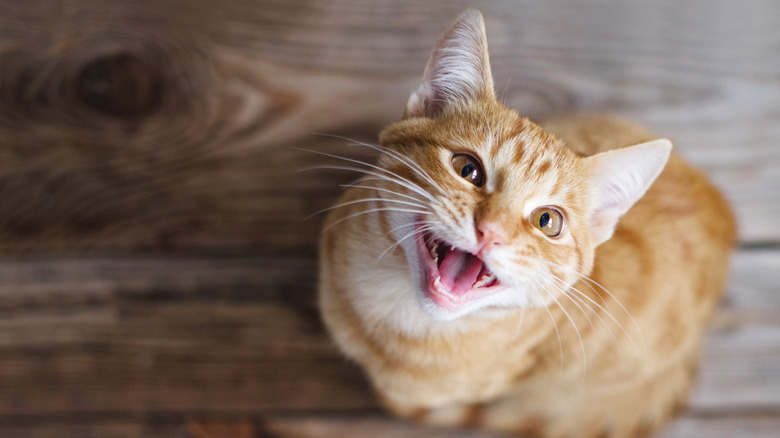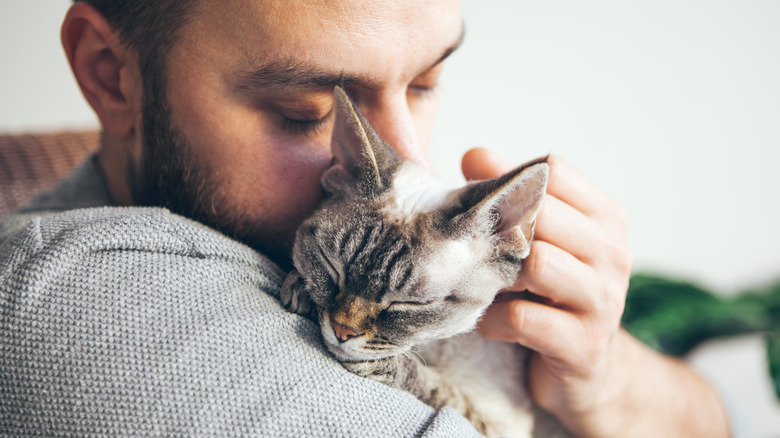Cats Can Recognize Your Voice. Here's What The Science Says
It's hard to pinpoint when cats were first domesticated, because it likely occurred at various times across the world. The oldest archaeological evidence comes not from Egypt and its cat hieroglyphics but from a burial site in Cyprus (via Science). Researchers found a cat was purpously buried next to a human grave around 9,500 years ago.
Out of the entire family of cats, or Felidae, only lions and cheetahs live communally (via Animal Cognition). The idiom "lone wolf" might be more accurate if it were lone leopard. In spite of their fierce independence, felis silvestris catus and homo sapiens grew closer over the centuries. Now that we share our homes, it seems both groups have changed their behaviors, bridging the gap in interspecies communication.
A growing body of work is reassuring cat owners that they aren't just living heating pads and cat food dispensers."There is really a special communication that develops between every owner and their cat," says the lead author Charlotte de Mouzon, an animal researcher at the University of Paris Nanterre (via National Geographic). Recent findings from her Animal Cognition paper provides further evidence that a special language develops between cats and their human companions.
Our embarrassing cat language
The human-pet research arena is dominated by canines, even though pet cats outnumber dogs in the U.S. by 10 million (via Animal Cognition). Sure, they don't always come when they're called, but cats place a special importance on the voices of their humans.
New research from Animal Cognition reassures cat owners everywhere that they're special to their feline companions. The researchers explored a phenomenon many owners will bashfully admit to. Owners often use a special baby-talk-like voice with their pets. Cat directed speech (CDS) is a style of speech pet owners wouldn't use with adult people. "Even knowing cats aren't human babies," explained de Mouzon to National Geographic, "we can still talk to them in a way they're sensitive to and that can reinforce our bond."
The study looked at a domestic cat's response to their owner versus a stranger. They also compared CDS to adult-directed speech (ADS). Owners were recorded saying four engaging phrases to their cat. They included "do you want to play?" and "do you want a treat?" They also recorded owners leaving a room with "see you later" and returning with a "how are you?" Owners were then asked to say the same phrases as if to an adult human. Strangers whom the cats in the study didn't know also said these phrases in their best CDS and ADS. By measuring the change in behavior caused by the phrases scientists measured what gets a cat's attention.
What cats want to hear
To get a domesticated cat's attention the owner should use their special and familiar CDS (via Animal Cognition). This motivated pets in the study to change their behavior. However, cats didn't respond to hearing their human companions use ADS. As for the strangers, they could be making the sweetest cat-directed baby talk possible, and still the felines kept right on with their important tasks such as sitting or grooming. This was surprising for researchers, because dogs respond to dog-directed speech by an owner or stranger (via Scientific Reports).
Cats can differentiate their owner from a stranger, and they prefer cat directed baby-talk (via Animal Cognition). "The fact that they're attentive to the different ways we speak to them, it shows how important we are to them outside of just feeding them or giving them shelter," de Mouzon explains, perhaps overstepping the findings (via National Geographic).
The authors admit it's possible cats are simply responding to a more familiar sound (via Animal Cognition). Another possible factor influencing cat responses has to do with the wide range of what CDS can sound like. Cats might learn the importance of their owners' form of CDS while other cat-baby-talk holds no meaning. De Mouzon and colleagues are looking into different characteristics of CDS in an upcoming project.
That's the cat's meow
But the conversation goes both ways. Just as humans use special voices when addressing our animals, it could be that our animals have learned special voices to use for us. Cats have developed unique ways to get what they want from their human underlings. Any cat owner will tell you, using ADS, that cats let you know when they're hungry.
Researchers in Current Biology discovered that requests for food aren't made with any old vocalization. In addition to head-bumps, cats have specific purrs designed for begging. Described as more urgent and unpleasant, even non-cat owners can distinguish these vocalizations as distinct from other purrs.
Looking at what sounds made up these annoying pleas, scientists found a hidden frequency within the calls. Within the solicitation purr there was a high frequency cry (via Current Biology). This special addition to the normal purr sound was at the same frequency produced by crying human babies (300-600 Hz). While this might be called manipulative, if it's a learned behavior to get a human's attention, it demonstrates a remarkable amount of intelligence.
Humans aren't the best cat translators
But is this learned anew by individual cats, or did the behavior develop through evolution? Research from Behavioural Processes found the meows of house cats are significantly higher than those of feral cats. It appears as though experience with humans leads cats to develop human-directed speech. This study seemed particularly challenging because getting a feral cat, let alone a domesticated one, to participate in a study is like, well, herding cats.
Humans probably didn't evolve for cat conversations because we're pretty bad at it. Previous research from Animals recorded cats meowing in various situations, including being isolated or brushed and waiting for food. The 225 participants listened to these meows and attempted to guess the situation. They did not do well. However, scientists did find females were better at distinguishing the meaning of meows. Experience and empathy towards cats also factored in, leading to better cat meow translation abilities.
Our feline friends have fully taken advantage of the anthropogenic niche we provided. The popular website Reddit features a section on a phenomenon called "not my cat." People share examples of furry freeloaders adopting humans by squatting. How many other animals could casually stroll into a house and take up residence? As we explore the back and forth between the 96 million pet cats in the U.S. and their owners, we learn more about how special it is to be known by a cat (via Animal Cognition).




